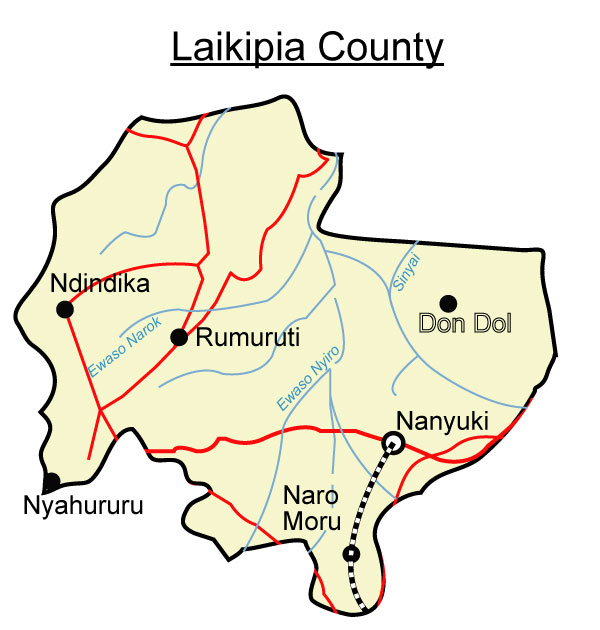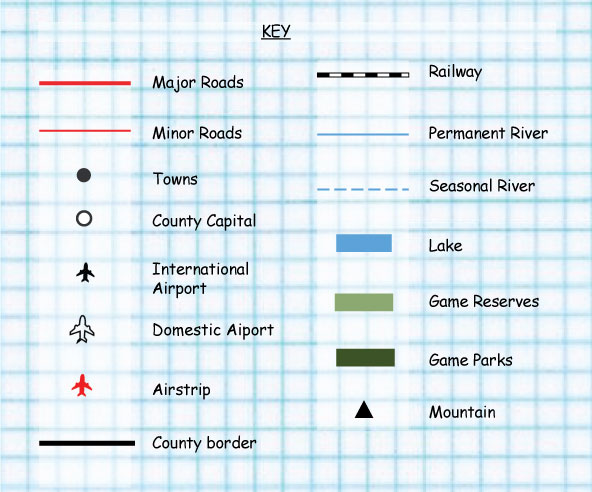It is located on the Equator in the former Rift Valley Province of the country. The county has two major urban centres: Nanyuki to the southeast, and Nyahururu to the southwest. Its capital is Rumuruti.

It consist of 3 constituencies
Rivers
Lakes
Mountains
Hills
Plains
Valleys


Maize (corn), milk and blood is Samburu's main food. The blood is drawn by piercing the vein of a cow with a spear or knife, after which the wound is resealed with hot ashes. They don't slaughter their animals very often. The Samburu tribe only eats meat on special occasions and during ceremonies such as the birth of a child, initiation and marriage.
Though they traditionally dressed in animal skins, Maasai woman with beaded jewelry - everyday Maasai dresstoday, typical Maasai dress consists of red sheets, (shuka), wrapped around the body and loads of beaded jewelry placed around the neck and arms. These are worn by both men and women and may vary in color depending on the occasion. Ear piercing and the stretching of earlobes are also part of Maasai beauty, and both men and women wear metal hoops on their stretched earlobes.
Women shave their heads and remove two middle teeth on the lower jaw (for oral delivery of traditional medicine). The Maasai often walk barefooted or wear simple sandals made of cow hide. - Songs and dances
When a Maasai child is born, he/she is not given an official name; rather, the child is given a temporary name, which is called the embolet, meaning an opening. From the day of his birth, until the naming ceremony is held, the child will be referred to using the embolet name. Maasai children are not all the same age when their naming ceremony is held. Depending on their family clans, some children may be as old as three years before the naming ceremony, which is called Enkipukonoto Eaji, meaning, coming out of the seclusion period. In the period leading up to the Enkipukonoto Eaji the mother and the baby remain in seclusion and let their hair grow long. During the naming ceremony, the hair is shaved off to symbolise a fresh start in the life of the child. For the kids that grow fond of their Embolet name, they are given that name permanently.
The people of the cattle developed their own rite of initiation called the sapana. Initiation by this ritual meant entry into one of two sets, either the tukoi (zebra) - so called because of the distinctive pattern of their brass jewellrey, or the nyimur (stone) in reference to their dark copper jewellrey.
Milk plays a huge role in a traditional Maasai diet. Drunk raw (or soured), drunk in tea, or turned into butter (which is especially important as a food for infants), milk is a part of almost every meal for Maasai herders.
Raw beef is also consumed, but much more fascinating is the tradition of drinking raw blood, cooked blood, and blood-milk mixtures.Blood is obtained by nicking the jugular artery of a cow precisely, allowing for blood-letting that doesn’t kill the animal. Mixed blood and milk is used as a ritual drink in special celebrations, or given to the sick.
Of course blood and milk aren’t the only things Maasai eat; the diet has always been supplemented with tubers, honey, and foraged plants that are most often used in soups and stews. More recently, Maasai have supplemented their diet with grains and maize meal (. They still play an important role in many Maasai meals, however; for example, ugali (a thick maize based porridge that serves as a staple food throughout Tanzania) is generally served with milk in Maasai households.
Maasai music traditionally consists of rhythms provided by a chorus of vocalists singing harmonies while a song leader, or olaranyani, sings the melody. Neck movements accompany singing.
Fishing
Main Trading prodcuts